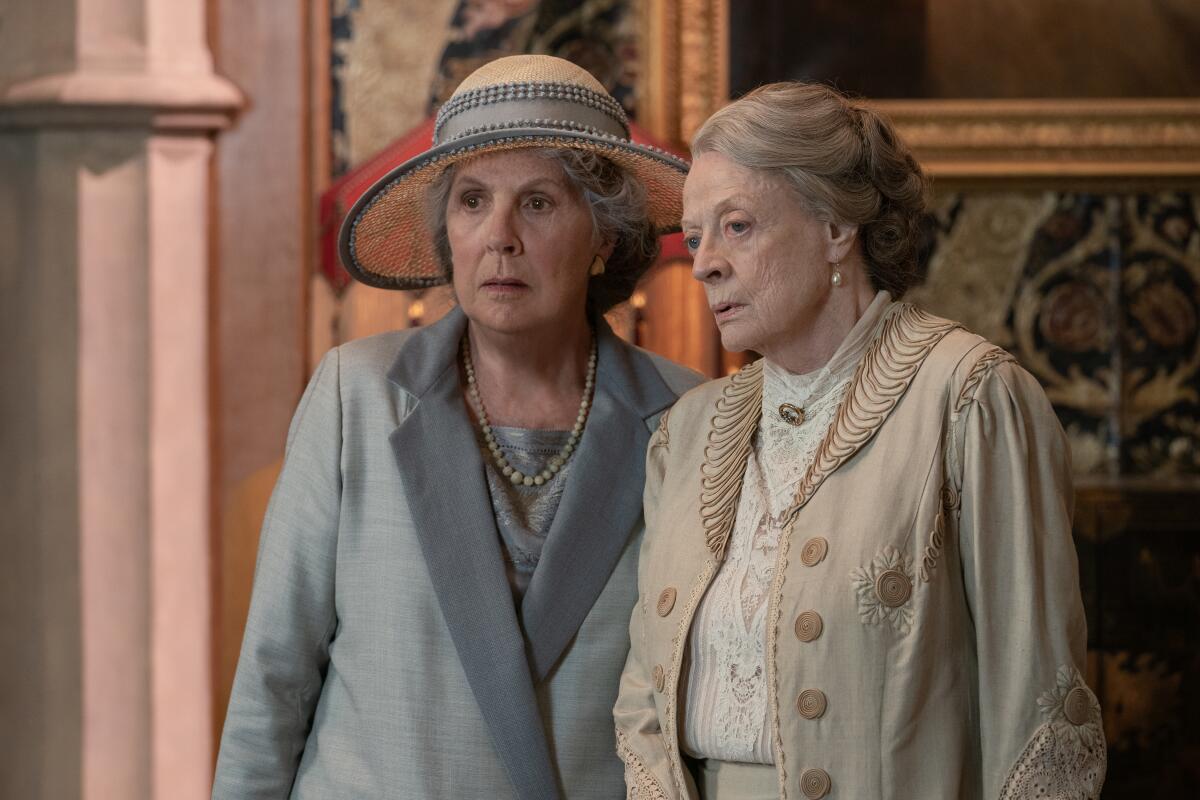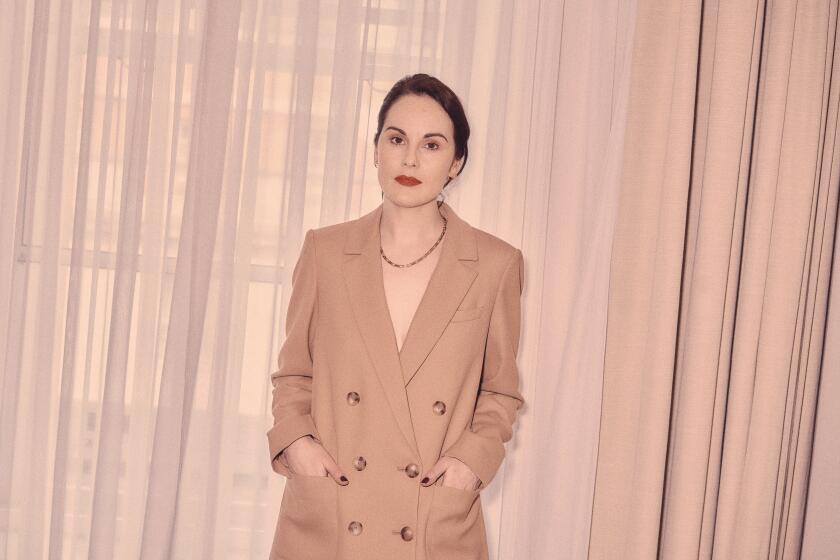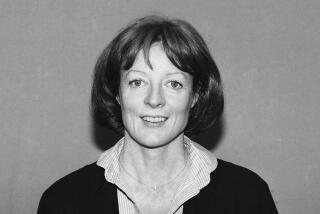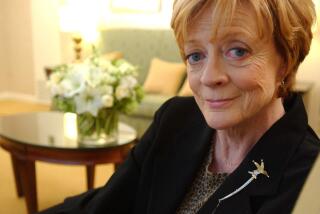Why ‘Downton Abbey’ had to say goodbye to that iconic character

- Share via
London — Spoiler warning: The following story includes plot spoilers for “Downton Abbey: A New Era,” the movie sequel now playing in theaters nationwide. If you haven’t seen the film yet, check out our review and feature on “Downton” star Michelle Dockery instead.
For six seasons and two movies, Maggie Smith’s Violet Crawley, Dowager Countess of Grantham, was both the emotional and comedic center of “Downton Abbey.” The deadpan matriarch of the family was always prepared with a one-liner or a dose of sensible advice, and she was the fan favorite in the beloved ensemble cast for many.
In “Downton Abbey: A New Era,” Violet arrives on her death bed and says a final farewell — a plot point that has left audiences in tears. But the decision to say goodbye to the character has been in the works for a while, as hinted at by the end of 2019’s first “Downton Abbey” feature.
“In the first film, we sort of hinted that she was in her final chapter, if you like,” explains screenwriter Julian Fellowes. “And that didn’t seem enough to me. I felt she’d been so iconic a character since the show began and so part of its great success that I felt we all wanted to make much more of it. So, we decided it was time. It’s quite moving, really. I know I’m writing it and it’s my fault, but these characters become so real to you over the years.”

Writing Smith out of the franchise was as much a practical decision as a narrative choice. The actress, 87, only signed on to each season of the original series on an annual basis, according to producer Gareth Neame — and it was never inevitable that she would stay forever. Neame also thinks of “Downton Abbey” like a book, with various chapters that need beginnings and endings. The filmmakers wanted “Downton Abbey: A New Era” to feel conclusive while also opening the door for future storylines.
“If this were to be the last film we ever make — I don’t know if it will be, there might be more — you want to make sure that you bring characters to a conclusion,” Neame explains. “And we tell the story of a family, and that story involves births, marriages and deaths, and the passing of the baton from generation to generation.
“We obviously set this up in the first film with the news that her health was declining. Where we go in this film and the eventual death of the character, I think it gives [the story] the bittersweet element. We always have the mixture of the tears and the laughter, which is what makes a family. Families are constantly going through sad and happy events.”
He adds, “The passing of the character will be sad but appreciated by audiences. [People have] commented on the fact it feels timely. Although it’s incredibly upsetting, it feels like the right way to tell the story.”
Violet’s death comes toward the end of the film, after a storyline about her past that brings some of the family to the South of France. As she dies, Violet’s loved ones, including her on-again-off-again rival Isobel (Penelope Wilton), gather around her bed to say goodbye.
The scene, shot in a set on a soundstage, was both technically and emotionally difficult to film. Director Simon Curtis, who joined the franchise for the first time on “A New Era,” describes the experience as “one of the most emotional days I’ve ever had filming.” There was a lot of discussion about where specific characters should be standing in the room and who should be together, some of which Fellowes had scripted. The scene was shot out of order because Curtis didn’t want the actors crying for an entire day unnecessarily. Instead, he saved the big reaction shots for the end.
“The two sisters can’t cry all day, right?” Curtis recalls. “The visual mathematics of shooting that scene was almost the biggest task that the cinematographer and I had to do.”
“The hardest part was keeping my emotions at bay during those scenes and trying to be Mary in those scenes and not Michelle because it was such an emotional day,” Michelle Dockery, who plays Lady Mary, remembers. “The silence on set — you could hear a pin drop. And it had been building. I think it was midway through the shoot, but that anticipation leading up to it was so emotional. I was sort of dreading it, actually. She’s been part of these last 12 years. We had to just hold back the tears before we could then let it go.
“I remember Simon Curtis, at one point, came over to me and Laura [Carmichael], in that shot where we embraced each other. I remember Simon saying, ‘You can let it go now.’ It makes me emotional just talking about it.”
Michelle Dockery couldn’t know how ‘Downton Abbey’ would change her life, and she hopes she’s not done with Lady Mary yet.
Hugh Bonneville, who plays Violet’s son Robert, the Earl of Grantham, says re-shooting the scene over and over again from various angles meant that the cast didn’t have a one-off emotional experience. Despite the technical nuance, however, the cast and crew wanted to maintain what Bonneville calls “respect and tenderness” on set. After the scene was over, the cast and crew gathered in Smith’s dressing room for a toast.
“The challenge is to preserve a sense of respect in the scene like that,” Bonneville says. “You don’t have people shouting at you, ‘Move the camera this way.’ People had a certain amount of dignity and calm about it because it will be an iconic moment, certainly for us as a cast. [But] I think the collective experience allows you to feel the emotions that all the characters are experiencing.”
Of course, Fellowes couldn’t conclude Violet’s story without one final zinger. Before Violet peacefully dies, she admonishes her lady’s maid Gladys Denker (Sue Johnston): “Stop crying, Denker. I can’t hear myself die.”
“I remember when I found it feeling relieved that I had found her last line,” Fellowes explains. “And I wanted it to be funny because I thought the scene would be fairly lachrymose, as indeed it is. But it’s nice to just have one laugh tucked into the middle of it. I thought that was that was good for her to go out undefeated.”
It was also essential for Fellowes that Violet remain an important part of the family until the very end.
“Violet has lived a long and interesting life and has been a dominating matriarchal figure throughout, so she never had to feel disempowered,” Fellowes says. “I think one of the saddest aspects of old age can be the disempowerment of people who, actually in their prime, were interesting and useful and clever and productive. And suddenly they’re being made to feel like this rather burdensome person who has to have a cup of tea.
“In a way, I hope that Violet is a statement back from that. She didn’t ever become a burden in that way, and she always was consulted up to the moment of her death.”
An on-location film shoot and a trip to the South of France lie in store for the Crawleys in a ‘Downton Abbey’ sequel that cheerily upholds the aristocratic status quo.
Violet’s elaborate funeral procession in the scene that follows was based on the real-life funeral of Deborah, the Dowager Duchess of Devonshire, held at Chatsworth in 2014. All of the tenant farmers lined the procession’s route at Chatsworth, which inspired Fellowes to do the same for Violet.
Some of the crew members even joined in as extras in the scene, which was another technical feat for Curtis. The filmmakers brought in the motorized hearse also used in the Fellowes’ scripted “Gosford Park” and carefully choreographed the camera movement across the faces of the family and staff. That scene was filmed outside Highclere Castle, which famously stands in for Downton Abbey.
“The big thing is they all love Maggie, they all loved working with her,” Curtis says of the cast. “It was the end of an era. We just pan across all those faces [and] there’s no gap between them as actors and as the characters. The emotion just reads on their faces. And as a director, you just count your lucky stars when you’re watching that on a monitor.”
Despite the tragedy of Violet’s passing, “Downton Abbey: A New Era” ends on a hopeful note, suggesting that the younger generations of the Crawley family will carry on the torch. It was important to everyone that the film leave a sense of optimism in its wake, as the franchise has done with its past pivotal deaths.
“The show is a warm blanket — many have described it that way,” Bonneville affirms. “You feel a sense of comfort when you hear that music start and you think, ‘I’ve taken away for an hour from the the trials and tribulations of the world in which we live.’ But nevertheless it does explore genuine human emotions and doesn’t shy away from them. It can be very funny, but it can earn its pathos and its pain.
“I think that’s probably one of the reasons for its survival over the years, that people do appreciate that Julian tells stories that are are three-dimensional. Into every into every life some rain must fall.”
‘Downton Abbey’ lost out to ‘Doctor Strange’ at the box office this weekend. But it was still a big win for older-skewing movies in the pandemic era.
More to Read
Only good movies
Get the Indie Focus newsletter, Mark Olsen's weekly guide to the world of cinema.
You may occasionally receive promotional content from the Los Angeles Times.












